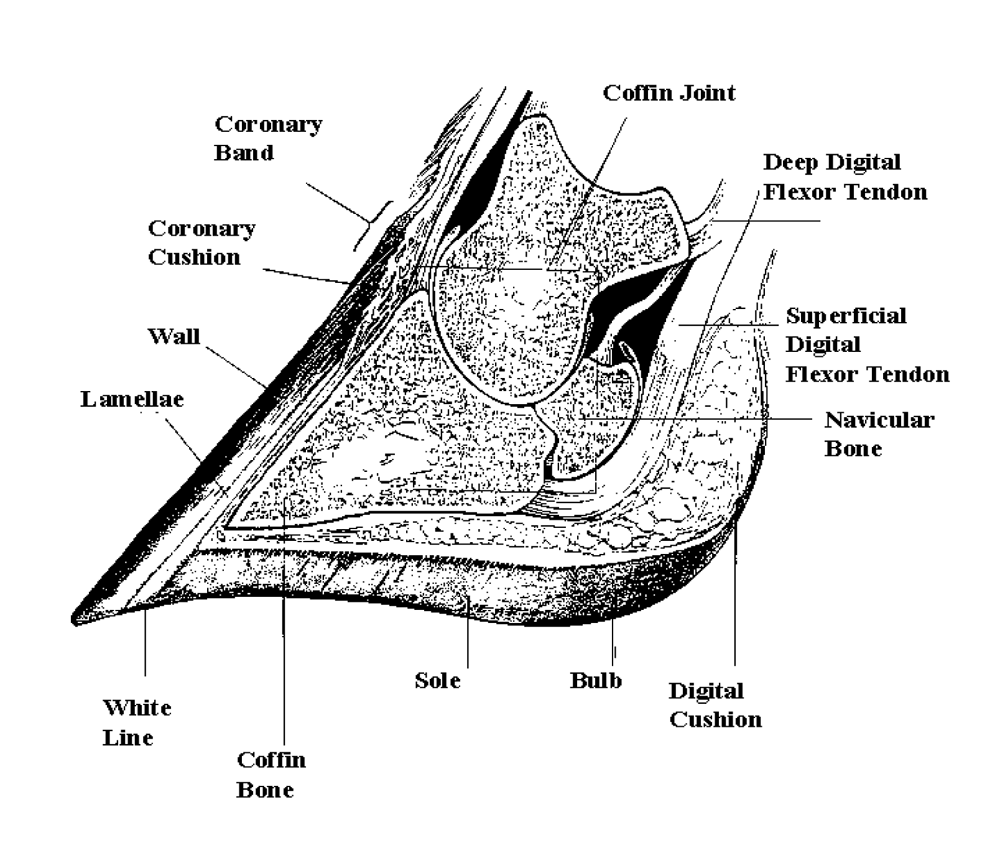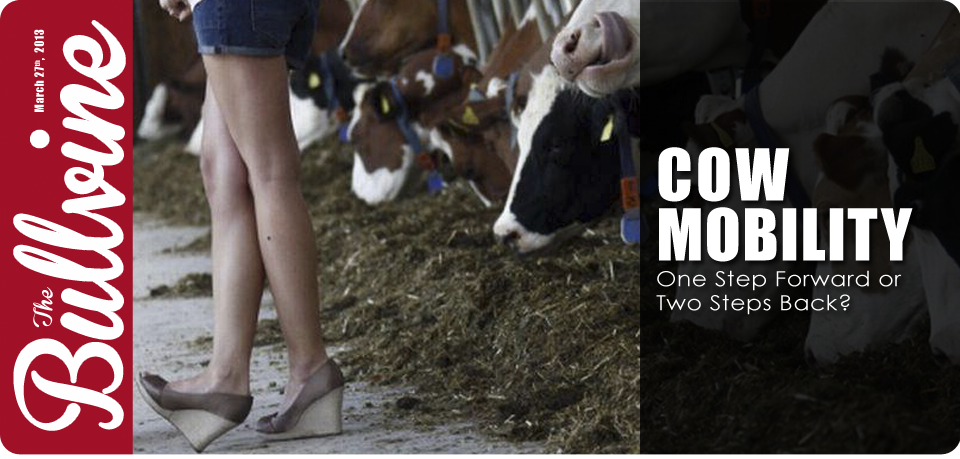The udder may be a cow’s most prized physical asset, but her feet and legs literally provide the support for everything she does. How many situations with problem cows boil down to problems with their feet and legs?
In most herds foot care and hoof trimming are considered to be a very necessary event and, therefore, an expense that cannot be avoided. With this absolute in mind, we tend to march on breeding, feeding and managing cows without taking the time to consider ways to stop merely treating the symptoms we`re stuck with. Solving the problem before it becomes a health or management problem could completely avoid starting our animals off on the wrong foot. The Bullvine invites you to consider the genetics of feet and legs with us to stimulate a breeding solution for these issues.
The Heels of a Dilemma
In milk recorded herds, culling cows for feet and leg problems is #1 on the list of conformation culling reasons. In the past, udder breakdown was once the leader. However breeders have placed sufficient emphasis on improving udders that we are now to the stage where milk producers are saying they do not need to select bulls for udder traits except to avoid ones that are too deep. It’s encouraging to know that with focus and time identified problems can be solved.
Although removal of horns may be the current hot button for people concerned about the welfare of animals, and therefore breeders are selecting for polled, there are numerous reports predicting that lame cows will be the next and much larger target.
Certainly, there are no dairypersons who are saying that feet and legs are good enough that genetic improvement for feet and legs is not needed.
Locomotion is Costing Us an Arm and a Leg
Reports show that for a cow with one temporary sore foot it reduces her annual profit by at least $100. So what is the cost of a cow with foot construction that requires trimming 3-5 times per year, medication, less milk production, milk withdrawal, extended calving interval and premature culling? Feet and leg problems could be costing some herds $300 per cow per year. On a one hundred cow herd that is $30,000 less profit. Significant by anyone’s standard.
A Vet Looks at the Genetics of Lameness
Gordon Atkins, DVM and a member of Holstein Canada’s Type Classification Advisory Committee, was a speaker at the recent annual meeting of the Wisconsin Holstein Association. He is not prepared to accept the fact that feet and leg heritabilities are as low as they currently appear to be. Additionally, he shared some interesting facts about feet and legs:
- Lameness is 88% a rear foot situation
- That leaves only 12% for it being a front feet and leg problem
- The outside rear claws bear the brunt of the lameness issue
- The fact is that the rear outside claw grows faster because it is growing tissue in response to the greater pressure it endures while walking
- Thin cows have a higher incidence of lameness
- Thin cows mobilized fat from their bodies including the fat from the foot pad or digital cushion within the base of the heel structure. This results in less protection for the foot and heel.
- The foot’s fatty pad can be replaced as the cow regains body condition but over time scar tissue will form when adequate fat is not present in the pads
Dr Atkins went on to highlight
- His very telling statement followed, that being, “we need to evaluate feet and legs better”

Diagram – Cross Section of a Bovine Foot
Let`s Go Toe to Toe with the Facts Only Please
Let’s summarize:
- Dairy cattle have a genetic problem relative to feet and legs especially for animals not allowed to get off cement or to exercise
- It is rear feet that are the major portion of the problem with respect to lameness
The Achilles Heel for Classifiers
The classification system scores numerous traits but there are factors in the area of feet and legs that are beyond their control. Foot angle is not a good trait to measure because it is so variable due to foot trimming. Cattle owners have feet trimmed before classification so type classifiers do not see the animals in their natural state. Classifiers do the best they can, given the circumstances. Add to this the fact that classifiers do not see every cow walking. Since the ability to walk is what is most important, classifiers again are at a distinct disadvantage.
Estimating heritability using classification data shows these percentages:
- 30% for bone quality (moderate)
- 24% for rear legs side view (moderate)
- 13% for rear legs rear view (low)
- 11% for foot angle (low)
- 8% for heel depth (low)
Yes the report card is in – we need to improve the evaluation feet and legs especially for rear feet and rear legs rear view. Genetically we have bred for thin cows and thus less fat in the foot pad. The only place we collect feet and leg data for genetic purposes is in the type classification programs and there the classifier, as mentioned, is at a disadvantage. What’s left that breeds, classifiers, people doing the genetic evaluations and breeders can do?
Getting a Toehold on the Solution
A collective approach is needed:
- We must admit that we have a problem and that we need to find a solution to more accurately knowing the genetics of feet and legs.
- The problem is not limited to one country and it is more prevalent in cattle not allowed to walk on natural surfaces.
- Resources (people and money) must be allocated to investigation and research.
Some suggestions the Bullvine has heard on ideas to consider include:
- observe or measure the females over their lifetime
- evaluate the feet on calves at weaning
- evaluate the feet on heifers at first breeding
- measure the feet on first lactation females on their first milk recording test day (before they are trimmed)
- compare sire’s daughter feet and legs on confined versus pastured daughters
- compare the genomic profiles of cow families that are both desirable and undesirable for feet (and legs)
It is encouraging to see that there is one hoof trimmers’ guild that has public support for a study to collect pedigree information at the time of trimming, to complete a report of the condition of the feet before trimming and then to have the data analyzed. That could be a start.
In the Interim… Feet Forward
Research takes time and cows are bred every day, in the mean time, breeders must use the information currently available from sire indexes or proofs. It is strongly recommended that sires be highly ranked for Net Merit, TPI or LPI and higher than 1.5 FLC or +7 Feet & Legs. A recent addition to the information to consider on bulls is their Body Condition Scoring index. Bulls whose daughters do not get as thin during lactation should not drain all the fat from their foot pads. (Some Bullvine recommended sires to use can be found at From Fantasy To Reality – Top Sires To Address Herd Culling Problems)
The Bullvine Bottom Line- “Stop “Digging in Our Heels”
What is needed is an international approach to studying dairy cattle feet, much like the approach being taken to studying feed efficiency. Hopefully a way will be found to move feet research in dairy cattle to the DNA level. If the industry collectively has the will, there will be a way. All we need now is a champion to take the first step.
Get original “Bullvine” content sent straight to your email inbox for free.


















I agree with the research needed in hoof health. I disagree with the statement that trimming 3 times a year is cutting into the dairy profitability. The majority of the industry does not invest enough in preventive maintenance trimming and that is why there is the high incidence of lameness in some herds. The majority of the herds have very similar genetics yet some very high incidence of lameness while others are extremely low. My clients that trim all cows every 5 months, trim 1st lactation heifers 6 weeks before freshening and run a good foot bath program have an incidence of lameness at 5% or less. Ontario, Alberta and BC have all collected data on hoof lesions but nobody has taken that data and gone back to research the top 1% of the herds to see what they are doing different than the other herds. I’m pretty sure it’s not the genetics they use but the hoof trimming program, foot bath protocols and overall cow comfort and management that bring them go the top. Let’s put the industry research dollars to good use and find some practical to reduce lameness not everything will be solved by DNA.